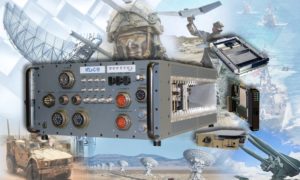
A Sensor Open Systems Architecture (SOSA) technical standard briefing at the Association of the United States Army annual conference outlined the future embedded computing design approach to developing and upgrading electronic warfare, signals intelligence, radar and communications applications for U.S. Navy, Army, and Air Force aircraft systems in near future.
SOSA is one of four open system standards that was mentioned in association with the Modular Open Systems Approach (MOSA) memorandum signed by Air Force, Army and Navy officials in January. Currently, the standard is in its preliminary second phase, with a final initial version expected to be completed by mid-2020, according to John Bowling, a U.S. Air Force technical expert for avionics architectures and interoperability who participated in the SOSA briefing.
The standard uses VITA’s OpenVPX architecture to allow the design and implementation of high-speed, high-power switched fabric-based systems that are capable of integrating single board computers into sensor platforms. What that could mean for flight control systems in the future is the easier introduction of new capabilities that only require the slotting in and out of cards with new capabilities on existing systems, rather than the type of massive re-wiring and hardware replacement that typically takes years to complete across defense aircraft programs.
“The end user pilot may not notice the difference between a proprietary box and SOSA built box, but everything behind it in terms of the operational energy and supply chain interaction will be radically different,” Curtiss Wright [CW] Chief Technology Officer Dave Jedynak said during the question and answer portion of the briefing.
The SOSA consortium is a collection of working groups organized by The Open Group, featuring embedded computing technology suppliers collaborating with Department of Defense (DoD) acquisition leadership to create modular open systems architecture specifications. These specifications are being developed to allow the reuse of key sensor components while maximizing intelligence, surveillance and reconnaissance (ISR) sub-system and platform re-configurability.
At the sponsor level, the SOSA Consortium includes the Air Force Life Cycle Management Center, Naval Air Systems Command (NAVAIR) and the Army Program Executive Office (PEO) for Aviation. Collins Aerospace [UTX], Lockheed Martin [LMT] and Raytheon [RTN] are also signed on as prime sponsors. BAE Systems, GE Aviation [GE], General Dynamics [GD], L3Harris [LHX], Northrop Grumman [NOC], and Sierra Nevada Corp. are members as well. More than 50 other embedded computing suppliers are associate level members.
Even as the SOSA technical standard remains in the development phase companies are using some its elements in their systems. Curtiss Wright’s new fifth-generation single board computer with an Intel [INTC] i7-based VPX3-1259 3U OpenVPX module features new SOSA slot profiles as part of a broader 3U OpenVPX convergence development platform.
“The processing solutions we’re looking at are fairly equivalent to what we’ve looked at for other safety critical processors,” Bowling said.
SOSA designs are also seen in the application development environment from Elma Electronics 3U 11-slot OpenVPX e-frame being exhibited for the first time at AUSA. The environment uses a Spectranetix software defined radio transceiver card and a Curtiss Wright 3U VPX position, navigation and timing card. According to Elma, the software-defined radio captures digitized signals from the timing card, and then sends that data over Ethernet using a high-speed switch, which then proceeds to populate the data within a graphical user interface for spectrum analysis. Using OpenVPX, the environment can support cards from multiple vendors.
Herrick Technology Laboratories, Pentek and Kontron have also developed a 3U VPX flight qualified chassis C4ISR demonstrator system, which the companies want to use to demonstrate the type of vendor interoperability that the three forces signed on for in their January memorandum. At the core of the system is a 40-gigabit Ethernet backplane and 4-lane PCI Express 3.0 expansion plane.
“The Pentek Jade Model 71813 directly addresses I/O needs called out in the emerging SOSA standards,” Pentek Chief Technical Officer Paul Mesibov said in a statement confirming the new demonstrator system.
Company proposals for the Army’s Future Attack Reconnaissance Aircraft (FARA) competition also feature the associated MOSA approach to avionics, including the integrated flight deck AVX/L3Harris is proposing for the program.
Next up for the SOSA consortium will be live demonstrations of potential SOSA technologies at the Tri-Service Open Architecture Interoperability Demonstration (TSOA-ID) in January 2020. The demonstration will be the first of its kind where Army, Navy and Air Force representatives will demonstrate the type of ease of interoperability that can be achieved using SOSA and other open systems standards.
This article was originally published in our sister publication Aviation Today.